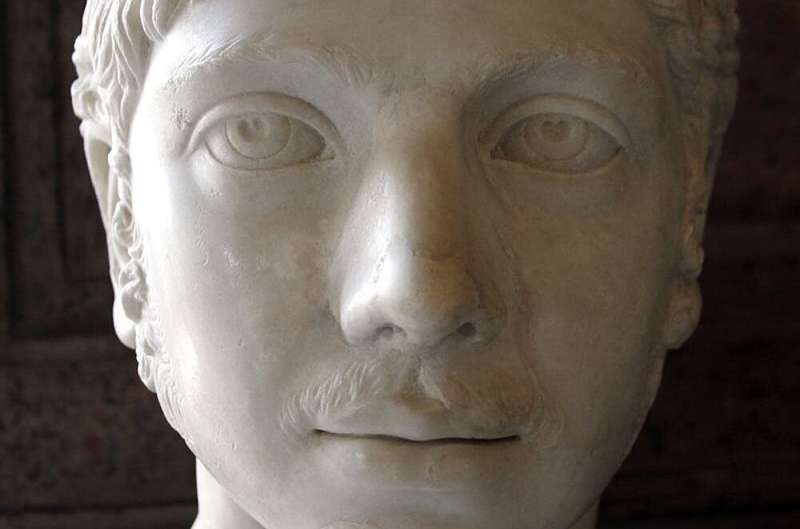This article has been reviewed according to Science X's editorial process and policies. Editors have highlighted the following attributes while ensuring the content's credibility:
fact-checked
trusted source
written by researcher(s)
proofread
Museum classifies Roman emperor as trans—but modern labels oversimplify ancient gender identities

Elagabalus ruled as Roman emperor for just four years before being murdered in AD 222. He was still a teenager when he died. Despite his short reign, Elagabalus is counted among the most infamous of Roman emperors, often listed alongside Caligula and Nero.
His indiscretions, recorded by the Roman chroniclers, include: marrying a vestal virgin, the most chaste of Roman priestesses, twice; dressing up as a female prostitute and selling his body to other men; allowing himself to be penetrated (and by the bigger the penis the better); marrying a man, the charioteer Hierocles; and declaring himself not to be an emperor at all, but an empress: "Call me not Lord, for I am a Lady".
Based on this quote, North Hertfordshire Museum has reclassified Elagabalus as a transgender woman and will now use the pronouns she/her. The museum has a single coin depicting Elagabalus, which is sometimes displayed along with other LGBTQ+ artifacts from their collection.
When writing about ancient subjects, from emperors to slaves, the first question historians must ask is: how do we know what we do? Most of our written sources are fragmentary, incomplete, and rarely contemporary, amounting to little more than gossip or hearsay at best and malign propaganda at worst. It's rare that we have a figure's own words to guide us.
Elagabalus is no exception. For Elagabalus, our principal source is the Roman historian Cassius Dio. A senator and politician before turning his hand to history, Dio was not only a contemporary of the emperor but part of his regime.
However, Dio wrote his Roman history under the patronage of Elagabalus' cousin, Severus Alexander. He took the throne following Elagabalus's assassination. It was, therefore, in Dio's interest to paint his patron's predecessor in a bad light.
Sexual slurs and the Romans
Sexual slurs were always among the first insults thrown by Roman authors. Julius Caesar was accused of being penetrated by the Bithynian king so many times it earned him the nickname "the Queen of Bithynia".
It was rumored that both Mark Antony and Augustus had prostituted themselves for political gain earlier in their careers. And Nero was said to have worn the bridal veil to marry a man.
The Romans were no strangers to same-sex relationships, however. It would have been more unusual for a Roman emperor not to have slept with men. Roman sexual identities were complex constructs revolving around notions such as status and power.
The gender of a person's sexual partner did not come into it. Instead, sexual orientation was informed by sexual role: were they the dominant or passive partner?
To be the dominant partner in business, politics, and war, as much as in the bedroom, was at the root of what made a Roman man a man. The Latin word we translate as "man," vir, is the root of the modern word "virile," and to the Romans, there was nothing more manly than virility. To penetrate—whether men, women, or both—was seen as manly, and therefore as Roman.
Conversely, for a Roman man to be passive, to be penetrated, was seen as unmanly. The Romans thought such an act of penetration stripped a man of his virility, making him less than a man—akin to a woman or, even worse, a slave.
A man who enjoyed being penetrated was sometimes called a cinaedus, and in Latin literature cinaedi are often described as taking on the role of the woman in more than the bedroom, both dressing and acting effeminately. The implication is always that the way they dressed, acted, and had sex was somehow subversive—distinctly un-Roman.
The word cinaedus appears in Latin literature almost exclusively as an insult—and it's this literary role that is ascribed to Caesar, Mark Antony, Nero, and Elagabalus. The power of the insult stems not from saying that these men had sex with men but that they were penetrated by men.
It's worth noting that these rules of Roman sexuality only applied to freeborn adult, male Roman citizens. They did not apply to women, slaves, freedmen, foreigners, or even beardless youths. These people were all considered fair game to a virile Roman man, as uncomfortable a concept as that might be to us today.
Was Elagabalus transgender?
While the Romans clearly engaged in acts that we today consider gay or straight sex, they would not recognize the sexual orientations we associate with them. The ancient Romans did not share the same conceptions of sexuality that we do.
Many men's sexual behavior was what we would now term bisexual. Some lived in a manner we might describe as gender non-conforming. The concept of a person being transgender was not unknown. But an ancient Roman would not have self-identified as any of those things.
We cannot retroactively apply such modern, western identities to the inhabitants of the past and we must be careful not to misgender or misidentify them—especially if our only evidence for how they might have identified comes from hostile writers.
In attempting to fact-check the sexual slurs and propaganda from the biographical facts, there is a danger that we lose sight of the fact that ancient Romans did recognize a huge variety of sexual orientations and gender identities—just as we do today. To attempt to crudely ascribe modern labels to ancient figures such as Elagabalus is not only to strip them of their agency but also to oversimplify what is a wonderfully, fabulously broad and nuanced subject.
Provided by The Conversation
This article is republished from The Conversation under a Creative Commons license. Read the original article.![]()


















